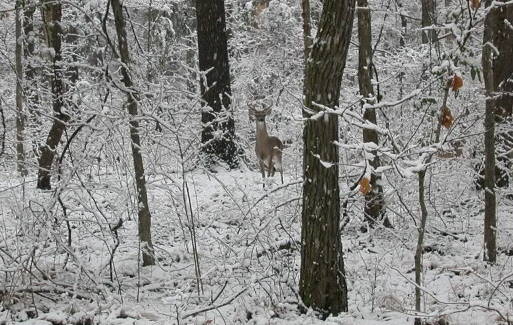As the snow falls today in Central Texas, I can’t help but think about the white-tailed deer throughout the country. I’m not just talking about the animals living right outside my door, but everywhere throughout the whitetail’s range. This is the time of year when habitat conditions are tough and when the nuts and bolts of deer population management are tested. After all, the white-tailed deer hunting seasons are over and the remaining deer are carryover, the core herd of the upcoming hunting season.
At the heart of deer population management is food availability. With late winter upon us, even though spring is just around the corner, white-tailed deer food is scarce over the landscape. Late winter is the most nutritionally stressful time of the year for a deer. At this point in time, the deer herd on every ranch should be at or below its base population size—the maximum number of animals that the habitat can support. Otherwise, the deer herd is at risk of a die-off from being malnurished due to inadequate food resources.

The ideal number of deer for a property can be somewhat subjective at the beginning of a deer management program, but keeping a close eye on habitat and deer body conditions will let landowners know where their base population should be. Less than desirable habitat conditions and lower deer body weights mean the population needs to be trimmed down even further. Big, healthy deer may suggest that the whitetail herd could be increased, but should it?
This is where two schools of thought regarding deer density and food availability collide. In nature, a given amount of habitat can only support so many animals until the food runs out. This law of nature obviously applies to white-tailed deer, but we as humans have the ability to add more food. Too many times, managers perceive the ability to add food to the system as a way to increase the number of animals that their property will support. However, this is just not so. Additional food does not increased the number of animals that the PROPERTY can support, it merely increases the total herd size.
So why is this a problem? The degree to which this becomes a problem depends on how far the actual deer population is from the ideal deer population for a particular property. A deer herd that is perfect in size for a property will have no problem getting through the nutritionally stressful times of late summer and late winter. This herd can even be provided with supplemental feed to ensure that all deer maintain maximum body condition and health, even though they don’t require it.
However, what happens as the deer herd gets further away, well above the ideal population size? Well, without the addition of food, deer begin to die. This is not just bad deal for the deer that have died, but an indicator that the herd is in poor condition. Once deer begin to die, you will be hard-pressed to find any deer that is in average to above-average condition within the herd. This is why deer seasons as we know them are in place—to maintain healthy deer herds.
But wait, why can’t we simply add more food and maintain more deer? Not only is this costly, but even as popular as supplemental feeding is, most properties do not have supplemental feeding programs for deer. Besides, food is only supplemental if the deer on a property can survive without it. If a deer herd requires feed, then it’s just that—feed. Removal of the feed jeopardizes every deer on the property and the herd.
In closing, winter is tough on all animals, including white-tailed deer. Looking out on this cold winter day makes me think about how limited food resources are during late winter in the deer’s natural environment. The most important component of white-tailed deer management is to keep the deer herd at a healthy level for the available habitat. Not only will this benefit the deer herd, but their habitat as well. And they need every last bit of it at this time of the year.